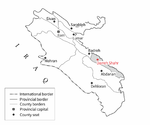Darreh Shahr
|
Darreh Shahr دره شهر |
|
|---|---|
| City | |

City view to the North
|
|
 Location in the Ilam province |
|
| Location in Iran | |
| Coordinates: 33°08′23″N 47°22′34″E / 33.13972°N 47.37611°ECoordinates: 33°08′23″N 47°22′34″E / 33.13972°N 47.37611°E | |
| Country |
|
| Province | Ilam |
| County | Darreh Shahr |
| District | Central |
| Neighborhoods |
List
|
| Government | |
| • Body | Governor |
| • Governor | Kheirollah Garavand |
| • Mayor | Mohammad Lorestani |
| • Council President | Mehrdad Mohammadi |
| Area | |
| • City | 3.05 km2 (1.18 sq mi) |
| Elevation | 660 m (2,170 ft) |
| Highest elevation | 695 m (2,280 ft) |
| Lowest elevation | 635 m (2,083 ft) |
| Population (2011) | |
| • Urban | 24,961 |
| Linguistics | |
| • Language(s) | Persian, Kurdish |
| • Dialect(s) | Lori, Laki |
| Time zone | IRST (UTC+03:30) |
| • Summer (DST) | IRDT (UTC+04:30) |
| Postal code | 69611 to 69691 |
| Area code(s) | +98 84 3522 |
| ISO 3166 code | IR-05 |
| Vehicle registration | ٩٨ ط |
| UFI code | -3059816 |
| JOG reference | NI38-12 |
Darreh Shahr (Persian: دره شهر; also Romanized as Darreh-ye Shahr) is a town and the capital of Darreh Shahr County, Ilam Province, Iran. It's situated in a wide valley in the northern hillsides of Kabir Kuh ranges. At the 2011 census, its population was reported 24,961. The ruined ancient city of Darreh Shahr Ancient City is located in the southern part of Darreh Shahr. It has been extensively excavated by archaeologists. The Seymarah River flows to the north of the city. The city has a lot of potentials in agriculture, rich water supplies, green fields and dense forests.
In ancient times Darreh Shahr has been the summer capital of Elam dynasty and it thrived on Sassanid Empire era.
In ancient times, Elamites governed the Lorestan mountains and constructed several strong buildings. Darreh Shahr was the first Elamite city attacked and destroyed by Assyrians in addition to the massacre of people. In Seymareh Valley the remains of the Sassanid monuments are still present; hence Darreh Shahr might have been a thriving city in the Sassanid and the Parthian periods. Furthermore, some foreign experts call the unearthed city as the second and lost capital of the Seleucids while some Iranian archaeologists believe that the monuments are part of the state of Sirvan. Referencing some resources and texts, Darreh Shahr may be the same as Mehr Jaan Ghazagh, Saabzaan, Seymareh or the city of Khosrau II in the late Sassanid period completely leveled to earth from an earthquake in the years 248 and 344 A.H.
...
Wikipedia

